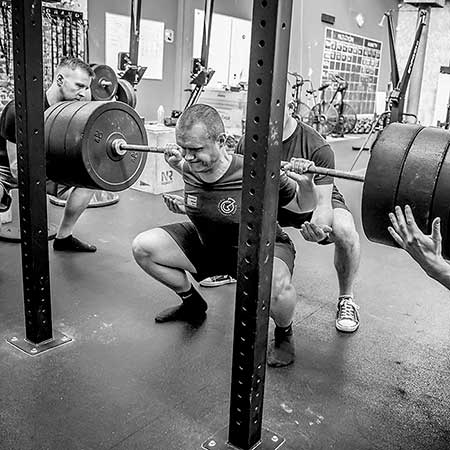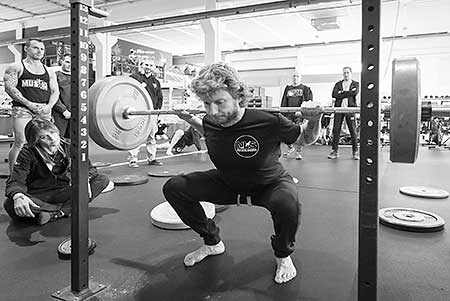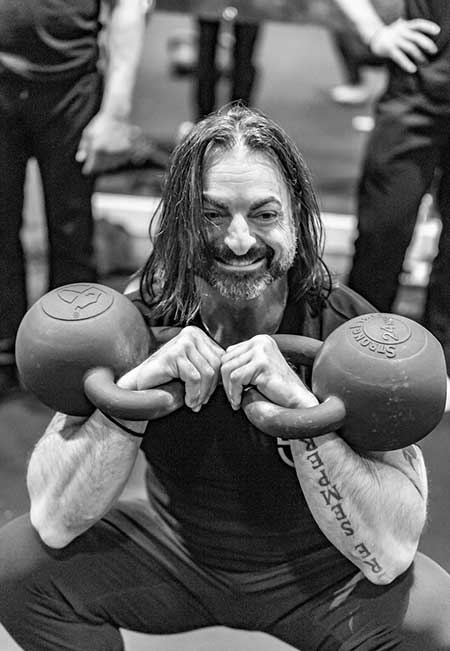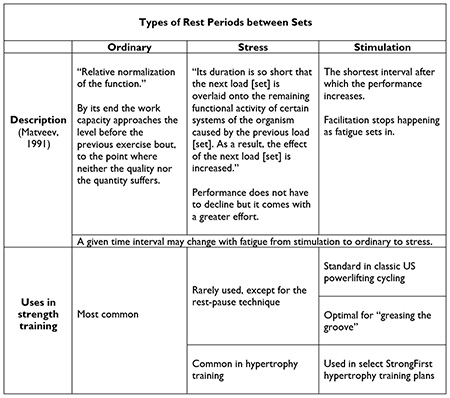
In a recent article, I explained how varying your lifting speed can help you gain more strength.
Today I will show you a couple of ways of applying this knowledge to boost your squat, barbell (back, front, Zercher) or kettlebell (goblet, double front).
3 x Gear Squat Protocol #1
The simplest thing you can do is to copy the most effective of the protocols in the classic Soviet study by Slava Lelikov:
- Lift three times a week: Monday—fast, Wednesday—medium, Friday—slow.
- Use 80{32c02201c4e0b91ecf15bfd3deecd875caca8b9615db42cfd45ce3d8de8d0829} 1RM x 3/5 (reps/sets) every time.
- Rest between sets: until you feel ready, then take another minute.
- Retest your 1RM after 5 weeks.
- Repeat for another 5 weeks.
The reps and the rest periods need explanations.
For a typical weightlifter 80{32c02201c4e0b91ecf15bfd3deecd875caca8b9615db42cfd45ce3d8de8d0829} 1RM roughly corresponds to 6RM—a weight he can lift six times with perfect form when going all-out. Three reps are half that. Why so few? Where is the “intensity”?
The answer is outside the scope of this article but students of Plan StrongTM know that Soviet weightlifters of all levels generally did 1/3-2/3 of maximal possible reps with a given weight. To stay with the 6RM example, two to four.

Which brings us to a situation when you do not know your exact 1RM, e.g., when squatting with kettlebells that take big jumps between sizes. No problem, use a “repetition maximum” to identify the right weight. 6-10RM will hit the spot.
Do half your max possible reps. E.g., if you are squatting with 8RM do sets of four reps. Aim for the same total of fifteen reps. Three sets of four add up to sixteen, close enough.
Note that regardless of the speed you are lifting at, the 6-10RM is established with a medium speed.
Retest your 6-10RM on Wednesday of week five.
There are two reasons to test on that day of the week. First, the explosive lifts on Monday will prime your nervous system. Second, according to Soviet research, an athlete is at his best in the middle of the week; on Mondays you are fresh but sluggish.

Onto the rest periods between sets. Prof. Leonid Matveev, the father of periodization, classified them as ordinary, stress, and stimulation:
Soviet weightlifters practiced “ordinary” rest periods—between “stress” intervals beloved by bodybuilders and “metcon” junkies and “stimulation” rests favored by old school American powerlifters.
Our 3x Gear Squat protocols also use ordinary rest periods. In other words, do not rush but do not lollygag. The cue of adding an extra minute after you feel ready comes from powerlifting coach extraordinaire Marty Gallagher.
If you are not good at listening to your body and insist on a number, make it 3min.
About speed:
- “Fast”—as fast as possible without jerking. Use compensatory acceleration.
- “Medium”—a comfortable, confident speed, corresponding to a first attempt in a powerlifting competition.
- “Slow”—the speed of a hard-fought PR single.
The above speeds refer to both the concentric and the eccentric halves of a rep—with one exception, the negatives on “fast Mondays.” Unless you are an experienced jumper or Olympic weightlifter, dropping into a squat is not a good idea. Descend briskly but do not “dive bomb.”
We love pauses on the bottom of squats but in the 3x Gear Squat protocols the reps are touch and go.
3 x Gear Squat Protocol #2
This more sophisticated plan plays with more variables in addition to the lifting speed: intensity (weight), volume (the total number of reps), and the proximity to muscle failure:

Note that you will be alternating weights from day to day, thus “Week A” and “Week B.”
Starting the week with speed, moving on to strength, and wrapping up with hypertrophy is a classic Soviet weightlifting tactic. Increasing the volume towards the end of the week and placing slow reps on the last training day of the week were parts of it.
Here is how to pick your reps and sets.
E.g., on a Monday you are squatting with your 7RM. The “reps per set” column specifies 1/3 RM.
7:3»2.3. Round down to 2. The day’s volume is ten reps. Do five sets of doubles.
Another example. You are lifting 11RM on a Wednesday and you are supposed to do 2/3 RM.
11:3×2»7.3. Round down to 7. The day’s volume is fifteen reps. Do a set of seven and a set of eight. You are a hair over 2/3 RM in your second set; it is okay.
A final example. It is a Friday with 5RM lifted for 1/2 RM.
5:2=2.5. You can round down to two reps or up to three. Why not both? Do ladders of (2, 3). Your volume is twenty reps, thus (2, 3) x 4.
Onto testing. You need to identify two weights, one in the 4-7RM range and another in the 8-12RM range. Here is how.
Start with a general warm-up of choice: joint mobility drills, etc. Then ramp up to your testing weight, an estimated 4-7RM.
Let us say that you been training with double kettlebell front squats (DFSQ) for easy sets of five with a pair of 24kg kettlebells (2x4kg x 5) and you can barely grind out a single with 2x32kg. Your ramp-up might look like this:
2x16kg x 5—very easy
2x24kg x 3—easy
You do not own 28kg kettlebells and you decide to test yourself with one 24kg and one 32kg. Being right-handed, you believe your left leg is the stronger one and load the right one with the 32kg.
(Test with more weight on your weaker leg but in training switch the heavy kettlebell from side to side every set.)
You manage five tough but perfect reps, your 5RM, and park the kettlebells.

An 8-12RM is next to test. Walk around and rest for a full 10min. Per Soviet research (Hippenreiter, 1966), it takes this long to restore your performance back to 100{32c02201c4e0b91ecf15bfd3deecd875caca8b9615db42cfd45ce3d8de8d0829} after an all-out set of reps in a strength exercise. (According to the same study, if you wait 20min, you might boost your max reps by 20{32c02201c4e0b91ecf15bfd3deecd875caca8b9615db42cfd45ce3d8de8d0829}—an example of “stimulation” rest periods—but it is not your goal.)
Then you go all-out with a pair of 24s and bag nine perfect reps, a 9RM. You have what you need to start the program and gain some serious strength.
3 x Gear Squat Protocol #3 and Beyond
You can make your programming simply sinister, highly sophisticated, or anything in between. Attend the Programming Demystified seminar and learn how.








